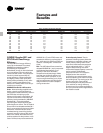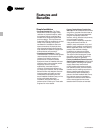
9RLC-PRC006-EN
Important
Certain application constraints should be
considered when sizing, selecting and
installing Trane air-cooled Series R
chillers. Unit and system reliability is
often dependent upon proper and
complete compliance with these
considerations. When the application
varies from the guidelines presented, it
should be reviewed with your local
Trane sales engineer.
Unit Sizing
Unit capacities are listed in the
performance data section. Intentionally
over-sizing a unit to assure adequate
capacity is not recommended. Erratic
system operation and excessive
compressor cycling are often a direct
result of an oversized chiller. In addition,
an oversized unit is usually more
expensive to purchase, install, and
operate. If over-sizing is desired,
consider using multiple units.
Water Treatment
Dirt, scale, products of corrosion and
other foreign material will adversely
affect heat transfer between the water
and system components. Foreign matter
in the chilled water system can also
increase pressure drop and
consequently, reduce water flow. Proper
water treatment must be determined
locally, depending on the type of system
and local water characteristics. Neither
salt nor brackish water is recommended
for use in Trane air-cooled Series R
chillers. Use of either will lead to a
shortened life to an indeterminable
degree. The Trane Company encourages
Application
Considerations
the employment of a reputable water
treatment specialist, familiar with local
water conditions, to assist in this
determination and in the establishment
of a proper water treatment program.
Effect Of Altitude On Capacity
Air-cooled Series R chiller capacities
given in the performance data tables are
for use at sea level. At elevations
substantially above sea level, the
decreased air density will reduce
condenser capacity and, therefore, unit
capacity and efficiency.
Ambient Limitations
Trane air-cooled Series R chillers are
designed for year-round operation over
a range of ambient temperatures. The
Model RTAC chiller will operature as
standard in ambient temperatures of 25
to 115°F/-4 to 46°C. With the low
ambient option, these units will operate
down to 0°F/-18°C. If an ambient
temperature as high as 125°F/51°C is the
basis for design, the high ambient option
will permit the chiller to run without
going into a limiting condition. For
installations in areas with large ambient
differences, the wide ambient option will
allow the chiller to perform uninhibited
from 0 to 125°F/-18 to 51°C. For
operation outside these ranges, contact
the local Trane sales office.
Water Flow Limits
The minimum and maximum water flow
rates are given in Tables G-1 and G-2.
Evaporator flow rates below the
tabulated values will result in laminar
flow causing freeze-up problems,
scaling, stratification and poor control.
Flow rates exceeding those listed may
result in excessive tube erosion.
Flow Rates out of Range
Many process cooling jobs require flow
rates that cannot be met with the
minimum and maximum published
values for the Model RTAC evaporator. A
simple piping change can alleviate this
problem. For example: A plastic injection
molding process requires 80 gpm
[5.1 l/s] of 50°F [10°C] water and returns
that water at 60°F [15.6°C]. The selected
chiller can operate at these
temperatures, but has a minimum flow
rate of 120 gpm [7.6 l/s]. The system
layout in Figure 4 can satisfy the process.
Flow Control
Trane requires the chilled water flow
control in conjunction with the Air-
Cooled Series R Chiller to be done by the
chiller. This will allow the chiller to
protect itself in potentially harmful
conditions.
Figure 4 — GPM Out of Range System Layout


















